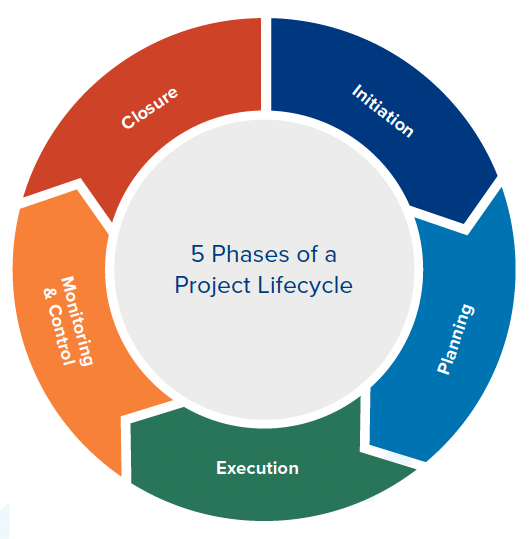
In this blog, we’ll recap our eBook, “Project Lifecycle Management (PrLM): A Comprehensive Guide. Click HERE to download the entire thing.
Project Lifecycle Management (PrLM): A Comprehensive Guide
Welcome to “Project Lifecycle Management (PrLM): A Comprehensive Guide.” In our eBook, we will explore the principles, methodologies, and best practices for effective project management throughout its lifecycle. Whether you area. seasoned project manager or someone new to the field, this guide will provide you with the knowledge and tools necessary to successfully navigate the various stages of a project and deliver exceptional results.
Project Lifecycle Management (PrLM) vs. Product Lifecycle Management
We know there is often some confusion between Project Lifecycle Management (PrLM) and Product Lifecycle Management (PLM) so just to set the stage, here is the high-level difference:
- Project Lifecycle Management (PrLM) — the focus of this paper — refers to the overall management of a project from its inception to its completion. It encompasses activities such as project planning, execution, monitoring, and delivery. PrLM focuses on managing the project-specific processes, resources, and deliverables to ensure successful project outcomes within the defined constraints of time, cost, and quality.
- On the other hand, Product Lifecycle Management (PLM) deals with managing a product from inception to delivery throughout the course of its entire lifecycle. PLM involves the strategic planning, development, and support of a product while taking into account factors like design, engineering, manufacturing, testing, distribution, and even customer service. Throughout its lifespan, it attempts to maximize the product’s quality, functionality, financial success, and market viability.
In summary, while PrLM is concerned with managing the overall project activities, PLM is focused on managing the lifecycle of a specific product, system, or software, including its development, production, and market presence.
With that clarified, let’s begin our journey into the world of Project Lifecycle Management.
RELATED: Traceable Agile – Speed AND Quality Are Possible for Software Factories in Safety-critical Industries
Understanding Project Lifecycle
What is a Project Lifecycle?
A project lifecycle refers to the series of distinct phases that a project goes through, from its initiation to its closure. It is a structured approach that helps project managers effectively plan, execute, and control their projects. Each phase of the lifecycle has specific objectives, deliverables, and activities that contribute to the overall success of the project. By understanding the project lifecycle, project managers can proactively manage risks, allocate resources efficiently, and ensure that project goals are achieved.
Importance of Project Lifecycle Management
Project lifecycle management is crucial because it provides a roadmap for project managers to follow. It enables them to break down complex projects into manageable stages, making it easier to monitor progress and track outcomes. By adhering to the project lifecycle, organizations can enhance their project success rates, improve resource allocation, and minimize risks.
Common Methodologies Used by Project Lifecycle Management
Project Lifecycle Management methodologies provide a structured framework for managing
a project from initiation to closure. It is important to note that because of the similarities in desired outcomes and development process cross-functionality, PrLM and PLM methodologies often overlap. Here are descriptions of some of the top PrLM/PLM methodologies:
- Waterfall Model – The Waterfall model is a sequential approach to PrLM. It divides the project into distinct phases, such as requirements, design, implementation, testing, and maintenance. Each phase must be completed before moving to the next. It’s suitable for well-defined projects with stable requirements.
- Agile PrLM – Agile PrLM is an iterative approach that emphasizes flexibility and collaboration. It allows for continuous feedback and adjustments throughout the project. Agile PrLM is ideal for projects with evolving requirements and a need for rapid iterations.
- Stage-Gate Model – The Stage-Gate model breaks the project into stages or phases, each with a decision gate where project stakeholders review progress and decide whether to proceed to the next stage. It’s useful for ensuring alignment with strategic goals and minimizing risks.
- Spiral Model – The Spiral model is a risk driven PrLM approach that combines elements of Waterfall and iterative development. It involves repeated cycles of planning, risk analysis, engineering, and evaluation. It’s suited for projects with evolving requirements and high uncertainty.
- V-Model (Verification and Validation Model) – The V-Model extends the Waterfall approach by emphasizing the importance of validation and verification at each phase. It highlights the relationship between development phases and corresponding testing activities, ensuring a robust validation process.
- Iterative and Incremental Model – This PrLM approach involves breaking the project into smaller, manageable increments that are developed and tested iteratively. It allows for early delivery of partial functionality and is commonly used in software development.
- PRINCE2 (Projects IN Controlled Environments 2) – PRINCE2 is a structured project management methodology that includes a well-defined project lifecycle. It focuses on governance, documentation, and clear roles and responsibilities, making it popular in government and public sector projects.
- Critical Chain Project Management (CCPM) – CCPM is a PrLM methodology that prioritizes resource management and identifies the critical chain of tasks that impact project completion. It aims to reduce project delays and improve resource utilization.
- Design Thinking – Design Thinking is a human-centered approach to PrLM that emphasizes empathy, ideation, and prototyping. It’s often used in creative and innovative projects to solve complex problems and improve user experiences.
- Hybrid PrLM – Hybrid methodologies combine elements of multiple PrLM approaches to tailor the methodology to the specific needs of a project. Organizations often customize their PrLM processes by selecting components from different methodologies. Selecting the appropriate PrLM methodology depends on the project’s nature, goals, constraints, and the organization’s culture. Project managers and teams may adapt or blend these methodologies to best suit the project’s unique requirements and dynamics.
RELATED: Requirements Traceability Benchmark
Common Phases of a Project Lifecycle
Although the specific phases may vary depending on the project management methodology used, there are typically five common phases in a project lifecycle: initiation, planning, execution, monitoring and control, and closure. Each phase serves a distinct purpose, from defining project objectives and creating a project plan to delivering the final outputs and conducting a post-project evaluation.
Grasping the fundamentals of project lifecycle management enables project managers to lay a strong foundation for their projects. The next chapter provides a comprehensive
overview of the project lifecycle, emphasizing its significance, the key stakeholders involved, and the challenges that may arise. With this knowledge, project managers can embark on their project journeys with confidence and a clear understanding of the path ahead.
Initiating the Project
Defining Project Objectives and Scope
The initiation phase is the starting point of a project, where the project objectives and scope are defined. This involves identifying the desired outcomes, deliverables, and benefits that the project aims to achieve. Clear and well-defined objectives help align the project team and stakeholders, providing a common understanding of what needs to be accomplished. Additionally, project scope defines the boundaries of the project, specifying what is included and excluded. It is essential to establish realistic and achievable objectives and scope to set the project on the right track from the beginning.
Conducting Feasibility Studies
Before committing resources and efforts to a project, it is crucial to assess its feasibility. Feasibility studies evaluate various aspects, such as technical, economic, operational, legal, and scheduling feasibility. This analysis helps determine whether the project is viable and aligns with organizational goals and resources. It allows
stakeholders to make informed decisions about proceeding with the project, modifying objectives, or exploring alternative approaches. Conducting thorough feasibility studies during the initiation phase minimizes the risk of undertaking projects that may prove unworkable or unprofitable in the long run.
Identifying Stakeholders and Their Requirements
Identifying and understanding project stakeholders is a critical step in the initiation phase. Stakeholders include individuals or groups who have a vested interest in or can
influence the project’s outcomes. It is essential to engage stakeholders early on to gather their requirements, expectations, and concerns. By involving stakeholders
from the beginning, project managers can gain valuable insights and build support and commitment for the project. This identification process lays the foundation for effective stakeholder management throughout the project lifecycle.
Developing a Project Charter
A project charter serves as a formal document that authorizes the existence of the project and provides a clear understanding of its objectives, scope, constraints, and stakeholders. It outlines the project’s purpose, defines the project manager’s authority, and establishes the project’s high-level requirements. Developing a project charter during the initiation phase helps align stakeholders, gain project sponsor approval, and set expectations. The project charter becomes a guiding document that shapes the project’s direction and provides a reference point throughout its lifecycle.
Establishing the Project Team and Roles
During project initiation, it is essential to assemble a capable project team and define their roles and responsibilities. This involves identifying the necessary
skills and expertise required for the project and selecting team members accordingly. Assigning roles and responsibilities clarifies expectations, promotes accountability, and ensures that all necessary tasks are covered. Building a cohesive project team in the initiation phase sets the stage for effective collaboration and lays the groundwork for successful project execution.
By effectively initiating a project, project managers establish a solid foundation for success. This chapter has explored the critical aspects of project initiation, including defining project objectives and scope, conducting feasibility studies, identifying stakeholders and their requirements, developing a project charter, and establishing the project team and roles. Through careful planning and consideration in the initiation phase, project managers can position their projects for smooth execution and set the stage for achieving the desired project outcomes.
This has been a preview of our eBook, “Project Lifecycle Management (PrLM): A Comprehensive Guide.
Click HERE to download the entire guide.
- FDA Issues Comprehensive Draft Guidance for Developers of Artificial Intelligence-Enabled Medical Devices - January 15, 2025
- 2025 Expert Predictions for Medical Device & Life Sciences: Innovations in Patient-Centered Care and the Future of Medical Device Design - January 9, 2025
- Jama Connect® Enables DevSecOps Through Robust API and Integrations That Connect All Activity to Requirements - January 7, 2025
